 |
VacationJune 1998"HMS" Rose |
 |
VacationJune 1998"HMS" Rose |
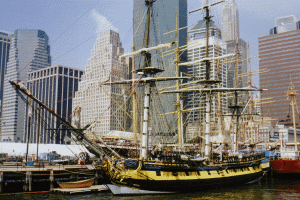
This past summer I took the longest stretch of vacation I had had since I graduated from college. One week visiting my brother, Kris, and his family in North Carolina, followed by two weeks aboard the Tall Ship "HMS" Rose. Since the trip was inspired by the "Gunroom" e-mail list, and many members (or "listswains" or "lissuns") were aboard, some references which may seem arcane will be understood by them.
I flew into Durham, NC, Saturday evening, June 13, and following Helen's custom, celebrated my mother's birthday with cake. Sunday we spent doing family things, but Monday, I drove up to Washington, DC. The object of this was to attend the MD/VA/DC Listswain Gathering. But first I spent as much of the day as I could at the National Air and Space Museum, where I met and lunched with Allan Janus, who with a name like that is known as the "List God." I must commend him for his hospitality, both at the Air and Space Museum and his home, where I saw his cache of Afghan rugs with military designs (they ARE real -- sometimes one is not sure whether things mentioned on the list are real or virtual.) He guided and drove us to the restaurant in Gaithersburg, where, as arranged by Susan Wenger, we met the other listswains. It was an evening of fine and friendly discussion.
Following the dinner, I drove back down to Williamsburg, VA, where I met my brother and family at Busch Gardens the next morning. If you are a roller-coaster fan, Busch Gardens has some real goodies! After a day of rides, Helen took the kids back to Durham in my rental, while Kris and I drove out to the barrier islands where he had some sales calls to make. It was good to get to know him again, having only had phone conversations with him since they had moved east five years ago.
Thursday, more family stuff, and Friday I took the train up to New York. Amtrak doesn't like me. Most of the trip went smoothly, but just out of Baltimore we got stopped by some track work. We lost an hour and a half there, and then another hour between Philadelphia and NYC. So I finally got in to Pennsylvania Station a little past 1 AM. I'd arranged to have a limo meet me, and thus I arrived at my hotel at about 2:30.
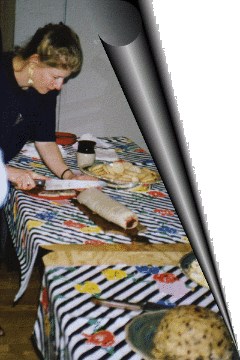 |
I spent the next day wandering about the South Street Seaport area, browsing the shops and the Pier 17 mall. I visited the Aubrey's World exhibit at the Seamen's Church Institute; and found a wine shop where I purchased a California Cab and a bottle of Graham's Six Grapes Port for later consumption at the Rosefest. Returning to the hotel, I waited for my father to arrive, and then we dodged raindrops back to the Seamen's Church Institute for the Rosefest party.
The trait in common of listswains is an instant camaraderie. There is no one I have met at any of the three list gatherings I have attended that I could not happily spend many an evening with. The Rosefest was an excellent example: Cookie and Lisa provided a truly wonderful meal of Lobscouse, pondoo, pickled salmon, a three-decker sea pie, ratafia biscuits, jam roly-poly, and, of course, a Spotted Dog with custard sauce. Herb and Don ran interference for them, while being perfect hosts; and as the various lissun's appeared, conversation broke out. It was eventually realized that name tags would be a good idea, and Hope and I ran out to see if we could find some reasonable facsimiles.
The following day we boarded the Rose-- and thanks to Paige for transporting our luggage from the hotel to the dock. The crew had been given shore leave and there were only a few left around: Todd, the 3rd Mate and the Willy Spurr, the engineer allowed us to carry our dunnage aboard and stow it temporarily on the gun deck. The gangplank was opened at 4 and the trainees and crew slowly assembled until everyone was aboard by 6 o'clock.
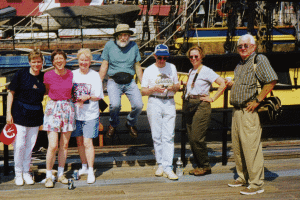 |
After dinner we were called on deck and assigned to our watches and divisions. I was on the 8-12 watch, with Brook, a former high school teacher from St. Louis as my mentor. This is the best watch for getting a full complement of sleep: in the rack at midnight, and roused for breakfast at 7:15.
That first evening was cold and damp with a thick fog obstructing our view. Before we got out of the East River we encountered the HMS Bounty, with which ship the Rose has a friendly rivalry. We motored out through the traffic and anchored ships waiting to enter the port, under the Verrazano Narrows Bridge, and into the Atlantic. My watch was on lookout duty for the trip out the harbor, and raised the staysails in complete dark once we were beyond traffic: ten complete lubbers under the direction of the crew. They put the ropes in our hands and told us when to haul. I now have complete sympathy for the sorry landsmen aboard Jack Aubrey's ships when they first sailed from England. The swell increased as we headed south-easterly, and a few trainees who were unprepared and unused to the motion began feel a bit queasy.
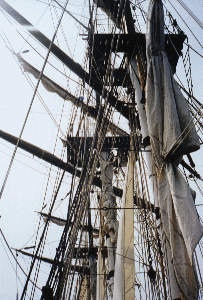 The
weather the first week was beautiful. Not a cloud, mild breezes and mild
temperatures. Unfortunately, the breezes were coming from the direction
we were headed. In order to sail to Bermuda, we would have had to travel
at least five times as far north and south of our intended course, wearing
ship instead of tacking since there wasn't enough wind to build up the
momentum to tack. So the engines were used the entire trip. The staysails
were up-- we had raised them Sunday night-- but the square sails would
have been counter-productive.
The
weather the first week was beautiful. Not a cloud, mild breezes and mild
temperatures. Unfortunately, the breezes were coming from the direction
we were headed. In order to sail to Bermuda, we would have had to travel
at least five times as far north and south of our intended course, wearing
ship instead of tacking since there wasn't enough wind to build up the
momentum to tack. So the engines were used the entire trip. The staysails
were up-- we had raised them Sunday night-- but the square sails would
have been counter-productive.
Each watch we learned about the working of the ship-- except sailing. The four-hour watch consisted of one hour doing "boat check," one hour on "bow watch," one hour at the helm and one hour "idle." For boat watch we would check the depth of the water in the fore-peak and each of the sleeping compartments, check that the bosun's stores and pantry were neat, read and note the engine gauges and pump the bilges as necessary. I found that the engine room was always hot and noisy, and my glasses would fog up whenever I entered, so reading the gauges was difficult. I also discovered that climbing down the very narrow hatch into the crew's quarters gave me some anxiety, being a little claustrophobic.
"Bow watch" was easy, since there was little or no other traffic. Once we spotted what appeared to be a humpback whale, and a few times we were joined by dolphins who rode our bow wave. Another watch got these visitors at night, and the bioluminescence rolling off their backs was "psychedelic" according to the watch-stander who saw them.
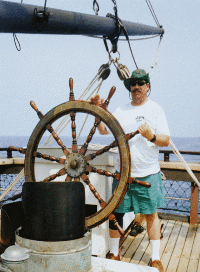 The
helm was my favorite station. Steering the
Rose was a challenge.
With the wind coming from directly ahead, the staysails were often a hindrance.
If the ship fell off a little, the jib and fore staysail would catch the
wind and pull her even farther. To counteract this the helmsman would have
to crank the wheel over until the ship stopped turning and began to come
back the other way, and then crank the wheel back to catch her before she
started falling off the other direction. We spent twenty minutes on the
wheel at most, the rest of the time we sat around and shot the bull.
The
helm was my favorite station. Steering the
Rose was a challenge.
With the wind coming from directly ahead, the staysails were often a hindrance.
If the ship fell off a little, the jib and fore staysail would catch the
wind and pull her even farther. To counteract this the helmsman would have
to crank the wheel over until the ship stopped turning and began to come
back the other way, and then crank the wheel back to catch her before she
started falling off the other direction. We spent twenty minutes on the
wheel at most, the rest of the time we sat around and shot the bull.
"Idle" was a real misnomer. The "idlers" did all the other work around the ship, such as cleaning the heads, doing dishes after meals, cleaning and sweeping the gun deck and anything else one of the ship's officers decided needed doing.
After an uneventful motor-boat trip to Bermuda, Captain Bailey had us set sail to enter St. George's Harbour. We were released to sight-see after the Customs officer toured the ship. My father and I took a bus ride tour of the island, stopping at the Aquarium/Zoo/Museum of Natural History for a while. We got back to the north island in time to join several others for dinner at the Blackhorse Inn in St. David.
Saturday morning Doug Gaunt, Lyn Paleo, Donnis Hobson and I took a taxi to the diving operation and spent the morning diving on the reefs west of the island. The first site was a sand channel frequented by large blue parrotfish. The coral reef was spectacular and we saw many colorful fish. The second dive was at the site of a shipwreck from the turn of the century. The ship was apparently carrying a circus and some of the wreckage included what was identified as a lion's cage. Among other (sea) animals, I saw a large purple-tipped sea anemone, inhabited by several translucent shrimp.
We returned to St. George's in time for lunch before boarding the Rose for our departure at 3pm. We set square sails again for leaving the harbor, and then turned south to get around Bermuda before turning west for Savannah.
If our destination had been Puerto Rico or the Virgin Islands, we would have been able to sail there: while we were heading south, Rose was sailing full with the wind on our quarter. But as soon as we turned west, we had the wind in our teeth again.
Sunday the breeze was mild but it picked up Monday and 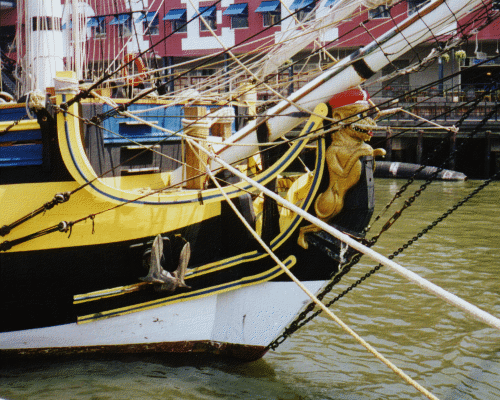 Tuesday
to between twenty and thirty knots, battering the bow of the
Rose,
bending the head rails and knocking half of "Chester's" face off. (Chester
is the Rose's lion figurehead.)
Tuesday
to between twenty and thirty knots, battering the bow of the
Rose,
bending the head rails and knocking half of "Chester's" face off. (Chester
is the Rose's lion figurehead.)
Wednesday morning Captain Bailey called all hands and gave us the option of turning north to Norfolk, Virginia, or running out of fuel somewhere east of Savannah. So we turned north-northwest. And so did the wind, though it dropped to near zero.
Thursday morning, I decided to skip breakfast and sleep in-- hell watch is brutal! But it wasn't to be. About 9:30 I was suddenly flung against the bulkhead next to my rack and then the other way, almost out of my bunk. This was followed by the sound of water flowing from the bilges into the compartment-- not an alarming event, since water in the compartment had been common since Monday. I rose and headed up to the weather deck to let the boat check team know they needed to pump A-compartment.
When I got to the deck, I decided that water in A was the least of worries. The sudden rolling I had felt was the result of the Rose being overtaken by a squall. The anemometer had been pegged at 60 knots and four of the sails had been blown out by the wind. Two of the crew, Andrew and Christina, had been aloft working on (I believe) the main topgallant yard when the wind hit, and had had to hold on for dear life!
After the torn sails had been unbent and sent below, two of them irrepairable and the other two requiring major work, Captain Bailey commented that it had been a $30,000 oops.
The next day we were close enough to shore to see the land. We passed the Cape Hateras light during the noon-to-4 watch, and bow watch actually had some use, as there were several boats and a few ships to be seen and, in some cases, avoided. We kept watching, even after our watch was over, because the scenery was relatively exciting after two weeks of empty sea.
We entered Chesapeake Bay during hell-watch, and we were again put to work looking out for boats and ships. This time it was more difficult, since all we could see were running lights. Occasionally, too, we were asked to spot certain way marks and buoys guiding us into Norfolk harbor. Four o'clock came around, and though I would have liked to watch as we approached and docked, sleep deprivation caught up with me, and I climbed down to the sleeping compartment and into my rack.
When I arose later that morning, the motion had stopped and we were in a berth alongside a mall in Norfolk. After breakfast, we finished packing and cleaned up the ship, some of us helping to carry what was left of the blown-out sails out to the lawn for Captain Bailey and Andy to evaluate whether they were salvageable. After lunch my father and I rented a car, loaded our gear into it and departed about 2:30 that afternoon, drove to Williamsburg and the next morning to Dulles International, whence we flew home.